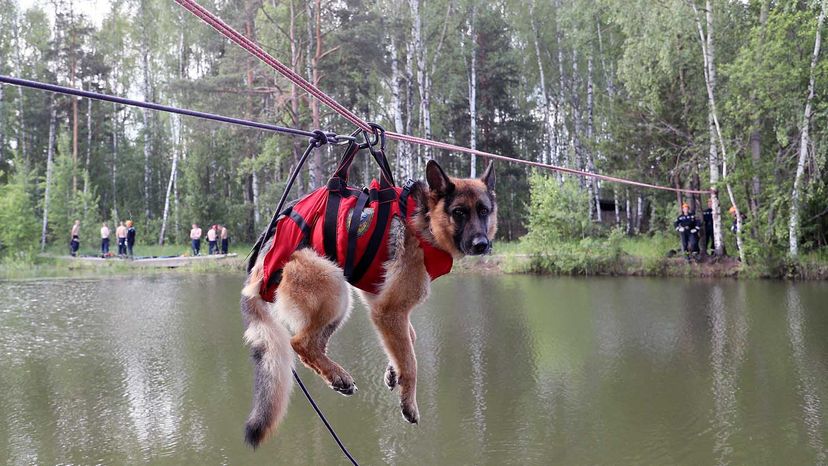Search-and-rescue Dog Basics

Experts estimate that a single search-and-rescue dog can search the same area as approximately 50 people on foot — and in far less time. How? First it's partly due to their keen sense of smell. Dogs have 220 million scent receptors, compared to humans' 5 million. But they're also fast.
Time is always an issue in search and rescue. In an avalanche, for instance, statistics show that more than 90 percent of people buried in snow can be rescued alive if they're dug out within 15 minutes. However, after 45 minutes, only about 20 to 30 percent are still alive, and after two hours almost no one buried by an avalanche is found alive. That means SAR dogs are invaluable in locating people alive when time is critical.
Advertisement
SAR dogs can do a lot of amazing things, including rappel down mountainsides with their handlers, locate a human being within a 1640-foot (500-meter) radius, find a dead body under water, climb ladders and walk across an unstable beam in a collapsed building, but it's all toward a single end: Finding human scent. This may be in the form of a living person, a dead body, a human tooth or an article of clothing. SAR dogs find missing persons, search disaster areas for survivors and bodies, and locate evidence at crime scenes, all by focusing on the smell of a human being.
This all might sound difficult to you, but to a SAR dogs, it's a breeze. Human beings are smelly creatures — they constantly shed dead skin cells called rafts, which contain bacteria and smell, well, distinctly human. While it's impossible to know for sure, most experts believe that SAR dogs are smelling these rafts, which form a "scent cone" that the dogs can easily pinpoint when they're performing a search. Everyone's skin cells smell unique, which is how a SAR dog can smell an item of clothing and search specifically for the last person who wore it.
While some dogs exhibit a stronger desire to scent than others, every canine out there has a powerful sense of smell. SAR dogs may be purebreds or mutts. Some handlers have a breed of choice, but any medium-to-large dog in good physical health, with decent intelligence, good listening skills, a non-aggressive personality and a strong play/prey drive (an intense, enduring desire to retrieve a toy) can potentially go into search and rescue.
SAR dogs need to be big enough to successfully navigate treacherous terrain and push debris out of the way and yet small enough to transport easily. German shepherds are a popular SAR breed; they're typically smart, obedient and agile, and their double-layered coat insulates against severe weather conditions. Hunting and herding dogs like Labrador and golden retrievers and border collies tend to be good at SAR work, too, because they have a very strong prey drive. Many people consider bloodhounds to be the best breed for tracking. Their giant ears and facial folds collect and concentrate scent particles right at their nostrils, making their sense of smell extremely powerful and discerning.
This brings us to a distinction between types of SAR dogs: Some dogs track, while other dogs search.